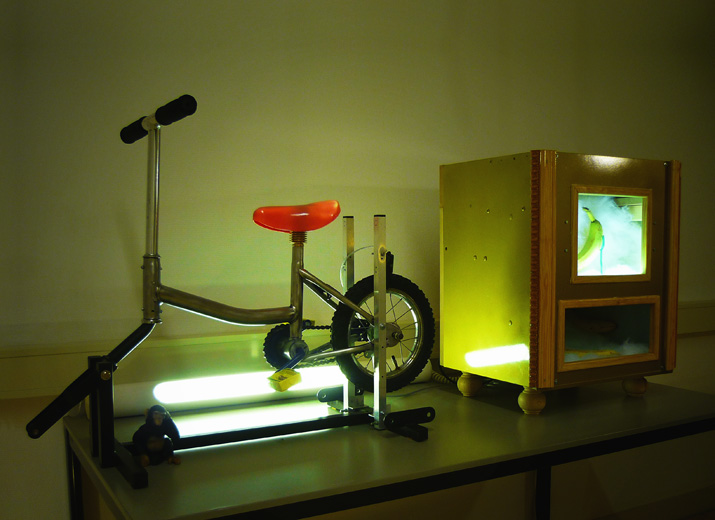Overview:
I was interested in the hypothesis that “Evolution may create the possibility that changes a property of life, which is self-centeredness.” , trying to approach this subject from an opposite viewing point. If a life form does not behave self-centered, does this altruistic act behavior lead to some kind of evolution, or not? The altruism-training-machine is a model to investigate this hypothesis by working with Chimpanzees.


Concept: Causality
Causality is the relationship between an event (the cause) and a second event, where the second event is a consequence of the first. In the Eastern philosophical tradition, this idea has worked as a kind of social control to people’s behavior. People believed that if someone does something wrong, something bad will happen to the person. On the other hand, if someone does something good, something good will happen to that person in return. This concept was used as base for this project

Method


Experiment image
Process
1. Preparing a system that has two different functions. The first part is an object that requires the chimpanzee to engage in physical work, in this case a custom small bike. The second part is a machine that supplies food for the chimpanzee similar to a vending machine, in this case however it supplies bananas. The two departments are connected and the food supply is triggered by a certain amount of physical work by the chimpanzee, cycling the bike.
2. Teaching the chimpanzees how to receive a banana by peddling the bike. The key is that only one banana will be supplied to (at least) two individual chimpanzees participating.
3. The bike and vending machine are placed apart at some distance. This distance limits the chimpanzee who is peddling the bike to take banana himself. If the chimpanzees want a banana, one of them has to peddle the bike and the other one is able to grab the banana from the vending machine.

I am investigating the question how both chimpanzees could react to this problem:
A. Both chimpanzees don’t peddle the bike because it appears fruitless.
B. The dominant chimpanzee gets the other chimpanzee to peddle the bike and takes the banana for himself.
C. One of them peddles the bike until the banana is supplied, then both start to fight for the banana.
D. The bike peddling is shared between two chimpanzees, the both cooperate to receive the banana and share it.
In case D, both chimpanzees take charge of the bike peddling. This system is using a technique of certification, like RFID. This certification system analyzes each chimpanzee’s peddling input. By analyzing if one of chimpanzee works more than the other, he consecutively will receive more bananas than the other.


Installation view at Kunstvlaai in Amsterdam, 2010
